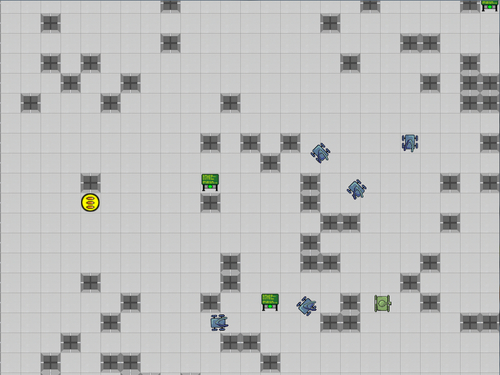- Add a new class called EnemyManager to the Robot Rampage project.
- Add the following
usingdirectives to the top of the class file:using Microsoft.Xna.Framework; using Microsoft.Xna.Framework.Graphics;
- Modify the declaration of the class to make it a static class:
static class EnemyManager
- Add declarations to the EnemyManager class:
#region Declarations public static List<Enemy> Enemies = new List<Enemy>(); public static Texture2D enemyTexture; public static Rectangle enemyInitialFrame; public static int MaxActiveEnemies = 30; #endregion
- Add the
Initialize()method to the EnemyManager class:#region Initialization public static void Initialize( Texture2D texture, Rectangle initialFrame) { enemyTexture = texture; enemyInitialFrame = initialFrame; } #endregion - Add the
AddEnemy()method to the EnemyManager class:#region Enemy Management public static void AddEnemy(Vector2 squareLocation) { int startX = (int)squareLocation.X; int startY = (int)squareLocation.Y; Rectangle squareRect = TileMap.SquareWorldRectangle(startX, startY); Enemy newEnemy = new Enemy( new Vector2(squareRect.X, squareRect.Y), enemyTexture, enemyInitialFrame); newEnemy.currentTargetSquare = squareLocation; Enemies.Add(newEnemy); } #endregion - Add the
Update()andDraw()methods to the EnemyManager Class:#region Update and Draw EnemyManager classEnemyManager classupdatingpublic static void Update(GameTime gameTime) { for (int x = Enemies.Count - 1; x >= 0; x--) { Enemies[x].Update(gameTime); if (Enemies[x].Destroyed) { Enemies.RemoveAt(x); } } } public static void Draw(SpriteBatch spriteBatch) { foreach (Enemy enemy in Enemies) { enemy.Draw(spriteBatch); } } #endregion - In the ComputerTerminal class, replace the
Update()method with the following:public void Update(GameTime gameTime) { if (Active) { float elapsed = (float)gameTime.ElapsedGameTime. TotalSeconds; LastSpawnCounter += elapsed; if (LastSpawnCounter > minSpawnTime) { if (Vector2.Distance(activeSprite.WorldCenter, Player.BaseSprite.WorldCenter) > 128) { if (EnemyManager.Enemies.Count < EnemyManager.MaxActiveEnemies) { EnemyManager.AddEnemy(MapLocation); LastSpawnCounter = 0; } } } activeSprite.Update(gameTime); } else { inactiveSprite.Update(gameTime); } } - In the
LoadContent()method of the Game1 class, initialize the EnemyManager:EnemyManager.Initialize( spriteSheet, new Rectangle(0, 160, 32, 32));
- In the
Update()method of the Game1 class, update the EnemyManager right after the GoalManager had been updated:EnemyManager.Update(gameTime);
- In the
Draw()method of the Game1 class, draw the EnemyManager right after the GoalManager has been drawn:EnemyManager.Draw(spriteBatch);
- Execute Robot Rampage. The computer terminals now spawn robots, which pursue your player tank:

Most of the EnemyManager class is standard for our managers. When an enemy is added via the AddEnemy() method, the enemy's currentTargetSquare member is set to the square that the enemy has been spawned in, meaning that on its first Update() cycle, it will execute PathFinder.FindPath() to determine a path towards the player.
..................Content has been hidden....................
You can't read the all page of ebook, please click here login for view all page.
